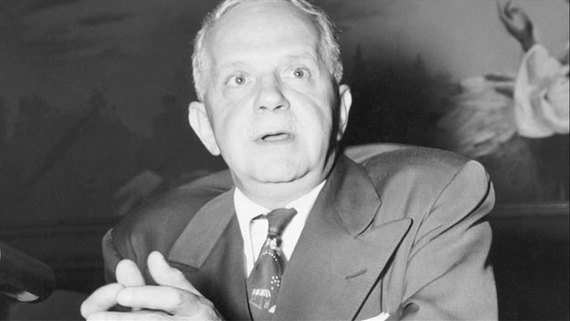The summer of 1919 had been a contentious one for a country in the throes of its first World War -- and under the radar, for a nascent Civil Rights movement. In the middle of the fury, a small, 26-year-old activist named Walter Francis White -- a black man who could pass as white -- had been sent by his employer, the National Association for the Advancement of Colored People (NAACP) to probe into dozens of lynchings and riots. But the unrest hadn't quite ended with the season-a three-alarm riot two thousand miles to the South sent White packing again.
On September 30, 1919, a group of disgruntled black sharecroppers in the small Arkansas hamlet of Elaine had instigated an insurrection, and a zealous, racist sheriff named Frank Kitchens, deputized 1,000 armed white men to put it down at any cost. When White finally arrived in Elaine -- under the guise of a white journalist -- he took note of the dozens of bodies strewn across the roads and the fields, then asked to speak with the black men the Sheriff had jailed on riot-related charges. Kitchens granted White the opportunity to interview the prisoners, and arranged to meet White at the courthouse.
In the end, White had to skip the engagement. As he walked toward the courthouse, White was overtaken by a black man who whispered, "Mister, I've got something important to tell you... I don't know what you are down here for, but I just heard them talking about you -- I mean the white folks -- and they say they are going to get you," he warned. "The way I figured it out is that if the white folks are so against you, you must be a friend of ours."
At that point, White remembered that only two trains left Elaine daily. He ducked down an alley and raced down the railroad tracks, climbing on to the station platform just before the afternoon departure. The conductor gave White an odd look. "But you're leaving mister, just when the fun is going to start," White recounted the man saying. "There's a damned yellow nigger down here passing for white...when they're finished with him, he won't pass for white no more!"
"No matter what the distance, I shall never take as long a train ride as that one seemed to be," White wrote in his memoir A Man Called White. When he finally set foot in New York, officials at the NAACP sighed with great relief. They heard news that White had indeed been lynched in Arkansas.
Nearly 100 years later, Americans have experienced a week of history repeating itself -- a bizarre, upended reminder that we have not effectively dealt with our past. To begin with, there is the case of Rachel Dolezal, a white woman, who, after earning a Master's Degree from Howard University, pursued social justice work for the black community in Spokane, Washington, albeit under the guise of a black, biracial identity. When a local television reporter exposed Dolezal's birth race, the NAACP initially backed its chapter president, issuing a statement that extolled her advocacy and claimed that "One's racial identity is not a qualifying criteria or disqualifying standard for NAACP leadership..." Several days later, amid a media circus, thousands of deriding tweets from the social mediasphere and death threats, Dolezal left her post despite, by all indications, a solid record of gains. In the end, Dolezal's "cultural appropriation" in the words of one Tweeter, ended her career because (she) wanted "all the attractive aspects of a culture without the painful parts."
Two days after the Dolezal story broke, nine people who gathered for Bible study at a historic black church in Charleston, South Carolina, were massacred when a 21-year-old man with a history of anti-black views opened fire on the group. In a season of racially motivated police shootings and brutality against blacks, the nation once again viscerally felt the legacy of racism that has lingered since post-Reconstruction. President Barack Obama quoted Dr. Martin Luther King, urging people to not just question the killer but "the system, the way of life, the philosophy which produced the murderers."
And once more, America's much-needed reckoning with our racism juggernaut has been substituted with hollow demands to remove the Confederate flag and an indictment against an individual for capitalizing on racial duplicity. As Americans collectively excoriated Dolezal, the cruel lesson came down in South Carolina illustrating that, in fact, we might actual need more Dolezals, despite our misgivings.
However, if Dolezal felt she might have an easier time of achieving her goals as a woman of mixed race, then cynically, she was likely correct. She need not look further than the example of Walter White.
A hundred years ago, Walter White used the lightness of his skin to advance the goals of the NAACP, to elevate the importance of the Harlem Renaissance and, in the process, raise his own profile as a black literary figure. Thomas Dyja, the author of Walter White: The Dilemma of Black Identity in America defined White as approximately 5/32nd black. But he added that White "always felt black because, in the most primal sort of identity politics, he had defined blackness as the way he saw the world".
With his vision, White investigated dozens of riots and lynchings, providing valuable information to the NAACP to help organize and combat the pervasive racism sweeping the country - incidents far more devastating than Charleston. Because of his moxie, White eventually rose through the ranks of the NAACP, and even successfully challenged W. E. B. DuBois, the esteemed African-American intellectual and top Civil Rights figure, for control. With that mandate, White achieved remarkable victories in his nearly 25 years as Executive Secretary: He successfully blocked the confirmation of Judge John J. Parker, a segregationist, to the Supreme Court; he gained the friendship of the White House, specifically, Eleanor Roosevelt, and attempted to institute a federal anti-lynching law; and he wrote the book, A Rising Wind, which helped convince President Harry Truman to desegregate the armed forces.
When White died in the fall of 1955, his funeral in Harlem was attended by thousands of blacks, who paid tribute to him for the work he did to advance civil rights. But even as they lauded him out of one side of their mouths, White's detractors were condemning him out of the other. White, they felt, had sold out the NAACP on many of its issues, compromising with - and capitulating to - the white leadership in D.C. He used his position to call attention to his own writing about his trans-racial experience. Finally, he divorced his black wife and married a white socialite, ultimately, in the NAACP's eyes, firming his grasp on white privilege. With the elevation of Roy Wilkins, a recognizable black man, to executive secretary, the NAACP took the first step in sweeping White's legacy under the rug, and with it, the horrors he exposed and spent his life trying to remedy.
Still, White's work was not all for naught. Without the public shaming white Americans felt when they read -- and saw photographs -- of the atrocities they committed against blacks, the might still be cheering the recent massacre in Charleston -- rather than denouncing it. Moreover, the demonstrations the NAACP organized in the 1920s based on White's work set the stage for the modern Civil Rights movement. Although White may never be properly remembered because of his skin color, he left a legacy. Rachel Dolezal will not. And in this racial climate, that is a loss for all of us.

